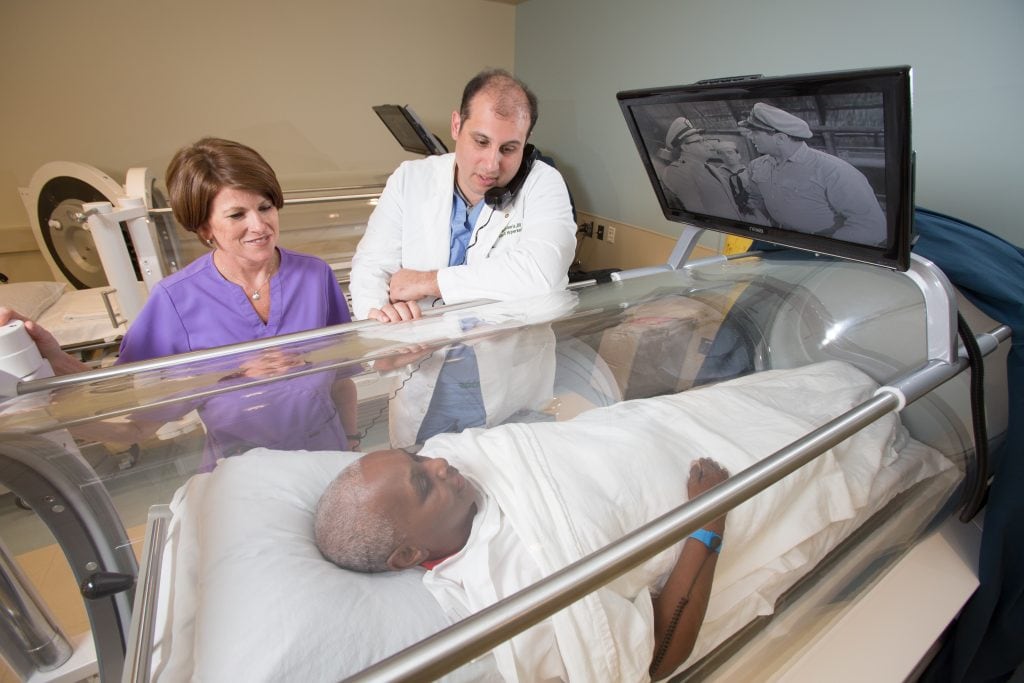What Is Hyperbaric Oxygen Therapy for Chronic Wounds?
You may have heard the buzz around hyperbaric oxygen chambers. Sports teams and cyclists love them, they cure deep-sea divers who get “the bends” (decompression sickness), and Michael Jackson was rumored to sleep in one (he denied it).
But what can these incredible machines do for the rest of us? Turns out these pressurized chambers can help heal a chronic wound when conditions including diabetes, cancer, and arterial and venous vascular disease have impaired the body’s normal healing.
So how does it work? Dimitrios Lintzeris, DO, CWS, medical director of Wayne UNC Health Care’s Wound Healing & Hyperbaric Center, answers some common questions.
What is hyperbaric oxygen therapy?
Simply put, hyperbaric oxygen therapy is a means of getting more oxygen to the body’s tissues to help your body heal from a wound.
It puts the whole body at an atmospheric pressure two to 2.5 times greater than normal, like going up in an airplane. You breathe 100 percent oxygen, compared with what we normally breathe—21 percent oxygen. With the higher atmospheric pressure, you dissolve more oxygen in your bloodstream and get it out to the tissue to help your wound heal.
Basically, it gives your body a big oxygen boost.

What are hyperbaric oxygen chambers for?
They’re used for several things. A number of professional sports teams have them to optimize athletic performance and assist in recovery from injury. Some people use them to promote cell growth and slow the aging process.
At Wayne UNC, we use the machines here to help heal chronic wounds.
What is a chronic wound?
If you cut yourself or have surgery and you’re healthy, your wound will heal in a matter of weeks. That’s a normal wound.
Chronic wounds are persistent, difficult and more complex. Examples include:
- Diabetic foot ulcers
- Osteomyelitis (bone infection)
- Arterial insufficiency (poor blood flow to your legs, feet or other parts of your body)
- Venous stasis ulcers (swollen legs)
- Radiation treatment-related problems
How does hyperbaric oxygen therapy promote the healing of chronic wounds?
Delivering an oxygen boost to your body’s tissues does several helpful things in terms of wound healing.
- When blood flow isn’t good, as in the case of a diabetic foot ulcer, additional oxygen delivered to the tissue helps the healing process. The body’s tissues need oxygen to heal.
- The oxygen will substantially improve how white blood cells help your body fight infections.
- The oxygen also promotes the growth of new blood vessels, which is also good for your body.
Basically, you’re creating a much better wound-healing environment when you boost the level of oxygen in your bloodstream. You’re maximizing the body’s ability to heal itself.
How does atmospheric pressure increase oxygen in your bloodstream?
Hyperbaric treatment substantially increases the amount of oxygen in the liquid part of your blood. Under normal conditions, the liquid part of your blood doesn’t carry oxygen. But with this treatment, the combination of pressure and high oxygen levels allows the liquid in your blood to become full of oxygen, which gets delivered throughout your body.
How often do patients get treatments, and how long do they last?
Usually, it’s daily 90-minute treatments for five days a week. Treatments last four to six weeks.
What’s it like inside the hyperbaric oxygen chamber?
The hyperbaric oxygen chamber is like an 8-foot-long canister in which you lie down on a comfortable roll-away bed. While you’re inside, you’re monitored by a specialized technician.
But be honest, is it scary?
It’s not. The chamber is completely clear. You can talk back and forth with the technician at any time. It’s relatively spacious. Most people just watch TV or a movie, or take a nap. You can see what’s going on around you, but, if you want privacy, there’s a curtain.
You’re never left alone. A technician is at your bedside the entire time.
Does insurance cover hyperbaric oxygen therapy?
Generally, yes, as long as you are referred by a doctor and need this treatment for medical purposes.
Interested in hyperbaric oxygen therapy? Request more information & learn more about our services!